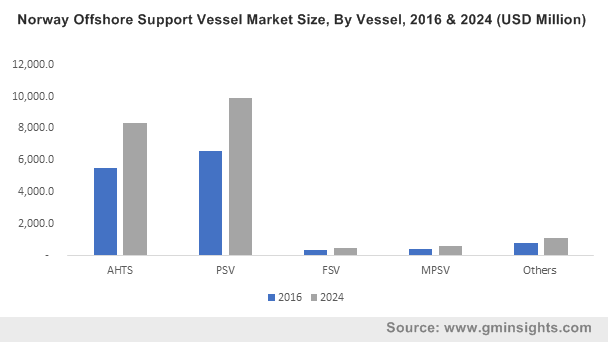Offshore Support Vessel Market Growth
Offshore support vessel market to accumulate substantial revenue from the expanding O&G sector, shifting trends toward the development of fuel-efficient vessels to boost industry growth over 2017-2024
The rapidly increasing exploration activities in the O&G domain have been favorably impacting offshore support vessel market trends. It is prudent to mention that macro-economy plays a significant role in energy demand, fueling the demand for offshore structures and vessels, inherently propelling offshore support vessel industry share. In fact, oil prices also play a crucial role in determining the demand for these vessels, pertaining to the relationship that exists between oil prices, number of profitable fields, exploration and requirement of offshore vessels. According to IEA (International Energy Agency), the global oil demand has increased noticeably as compared to 2013, which has had a considerable impact on offshore support vessel market outlook. Considering the increasing requirement of offshore vessels, in 2014, the OECD Council Working Party on Shipbuilding had even arranged a workshop on offshore and shipbuilding industry for government partners, industry experts, and marine equipment firms. Today, numerous giants in offshore support vessel industry are increasingly investing in development of energy efficient and green vessels, pertaining to environmental safety. The shifting trends toward the development of eco-friendly shipbuilding is thus slated to augment offshore support vessel market size, pegged at USD 40 billion for 2016.
U.S. Offshore Support Vessel Market, By Vessels, 2016 & 2024 (USD Million)

Nowadays, many of the small-scale marine transportation companies and renowned giants in offshore support vessel industry are collaborating with oil production companies to supply long-term fuel sources. For instance, in November 2017, Harvey Gulf International Marine announced a deal with Shell Trading to transport LNG to the ports of Caribbean and Florida. In consequence, this is likely to encourage other offshore support vessel market players such as Solstad Farstad, Tidewater, Maersk, Vroon, REM Maritime, Edison Chouest, Swire, Seacor Marine, Island Offshore, Harvey Gulf, GulfMark Offshore, Inc., and Havila Shipping to establish joint ventures with oil and gas exploration companies. In addition, the acquisition of major shipping lines by reputed companies is also expected to propel offshore support vessel market size. For instance, recently, one of the largest suppliers of ship and supply vessels, Maersk successfully acquired the North Korean ocean trader, Hamburg Süd.
Get a Sample Copy of this Report:@ https://www.gminsights.com/request-sample/detail/1306
Considering the lucrative business opportunities in offshore support vessel industry, many iconic automakers have been penetrating the domain of ship manufacturing. For instance, the British carmaker, Rolls Royce has revealed its concept of high-tech superyacht with a hybrid propulsion system that operates on the combination of LNG (Liquefied Natural Gas) and battery power. It has also implemented an intelligent dynamic locating system and improved radar system. Technological advancements of this degree are certain to help offshore support vessels be comfortably positioned near oil rigs, which is likely to propel offshore support vessel industry size over the years ahead. In addition, the Scotland based offshore engineering company, CDC Scotland Ltd., has also been involved in the development of revolutionary designs for offshore support vessels. A leading provider of advanced self-elevating and self-propelled support vessels for offshore gas, oil, and renewable energy sectors, Gulf Marine Services is also reported to be making strategic acquisitions to maximize vessel utilization – a strategic move on its part that would impact offshore support vessel industry trends.
Offshore vessel designers are looking forward to diversifying the design of support vessels. Recently, the Europe based OSD-IMT has signed an agreement with US-based Gibbs & Cox to provide innovative vessel designs for commercial applications across United States. Under this agreement, both the partners would be developing efficient and cost-effective vessels. The aforementioned instance strongly underlines the plethora of investments in offshore support vessel industry. The surging introduction of new products would thus catalyze offshore support vessel market size, which will surpass a revenue collection of USD 60 billion by the end of 2024.
Author Name : Sunil Hebbalkar
